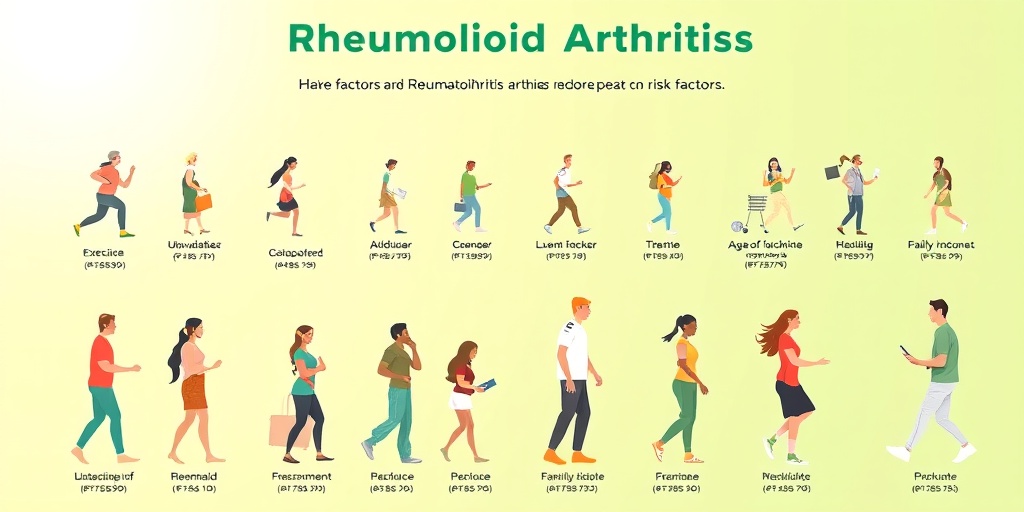What Is Rheumatoid Arthritis?
Rheumatoid Arthritis (RA) is a chronic autoimmune disorder that primarily affects the joints, leading to inflammation, pain, and eventual joint damage. Unlike osteoarthritis, which is primarily caused by wear and tear, RA occurs when the immune system mistakenly attacks the synovium—the lining of the membranes that surround the joints. This can result in a range of symptoms and complications that extend beyond the joints, affecting overall health.
The Autoimmune Aspect
In RA, the body’s immune system, which is designed to protect against infections, becomes overactive and targets healthy tissues. This autoimmune response can lead to significant joint damage if left untreated. The exact cause of RA remains unclear, but genetic, environmental, and hormonal factors are believed to play a role.
Who Is Affected?
Rheumatoid Arthritis can affect individuals of any age, but it most commonly begins in middle age. Women are more likely to develop RA than men, with a ratio of about 3:1. The disease can also occur in children, known as juvenile idiopathic arthritis.
Types of Rheumatoid Arthritis
RA can manifest in various forms, including:
- Seropositive RA: Characterized by the presence of specific antibodies in the blood, such as rheumatoid factor (RF) and anti-citrullinated protein antibodies (ACPA).
- Seronegative RA: Patients do not have these antibodies, but still exhibit symptoms of the disease.
- Palindromic Rheumatism: A rare form where symptoms come and go, often affecting the same joints.
Rheumatoid Arthritis Symptoms
Recognizing the symptoms of Rheumatoid Arthritis is crucial for early diagnosis and treatment. Symptoms can vary widely among individuals, but some common signs include:
Joint Symptoms
The hallmark of RA is joint pain and swelling. Common joint symptoms include:
- Morning Stiffness: Many individuals experience stiffness in the joints, particularly in the morning or after sitting for long periods.
- Symmetrical Joint Involvement: RA typically affects joints on both sides of the body, such as wrists, knees, and fingers.
- Swollen Joints: Inflammation can cause joints to appear swollen and feel warm to the touch.
Systemic Symptoms
RA is not limited to joint issues; it can also cause systemic symptoms, including:
- Fatigue: Many individuals report feeling unusually tired, which can be debilitating.
- Fever: Low-grade fevers may occur during flare-ups.
- Weight Loss: Unintentional weight loss can happen due to the body’s inflammatory response.
Other Complications
In addition to joint and systemic symptoms, RA can lead to other complications, such as:
- Rheumatoid Nodules: Firm lumps that develop under the skin, often near affected joints.
- Organ Involvement: RA can affect organs such as the lungs, heart, and eyes, leading to additional health issues.
- Increased Risk of Other Diseases: Individuals with RA may have a higher risk of developing other autoimmune diseases, such as lupus or Sjögren’s syndrome.
When to Seek Help
If you experience persistent joint pain, swelling, or stiffness, it’s essential to consult a healthcare professional. Early diagnosis and treatment can significantly improve outcomes and help manage symptoms effectively. Resources like Yesil Health AI can provide evidence-based health answers and support your journey toward better health.
In conclusion, understanding Rheumatoid Arthritis is vital for those affected and their loved ones. By recognizing the symptoms and seeking timely medical advice, individuals can take proactive steps to manage this chronic condition and maintain a better quality of life. 🌟

Rheumatoid Arthritis Causes
Rheumatoid Arthritis (RA) is a chronic inflammatory disorder that primarily affects the joints but can also have systemic effects on the body. Understanding the causes of rheumatoid arthritis is crucial for effective management and treatment. While the exact cause remains unclear, several factors contribute to the onset of this autoimmune disease.
Genetic Factors
Research indicates that genetics play a significant role in the development of RA. Individuals with a family history of rheumatoid arthritis are at a higher risk of developing the condition themselves. Specific genes, particularly those related to the immune system, may predispose individuals to autoimmune responses that lead to joint inflammation.
Environmental Triggers
Environmental factors can also trigger rheumatoid arthritis in genetically predisposed individuals. Some of these triggers include:
- Infections: Certain viral and bacterial infections have been linked to the onset of RA. For instance, the Epstein-Barr virus has been studied for its potential role in triggering autoimmune responses.
- Smoking: Tobacco use is a well-established risk factor for RA. It not only increases the likelihood of developing the disease but can also exacerbate its severity.
- Obesity: Excess body weight can contribute to inflammation in the body, potentially triggering or worsening rheumatoid arthritis.
Hormonal Factors
Hormones may also influence the development of rheumatoid arthritis. The disease is more prevalent in women than men, suggesting that hormonal differences could play a role. Fluctuations in hormone levels, particularly during pregnancy or menopause, may impact the immune system and contribute to the onset of RA.
Immune System Dysfunction
At its core, rheumatoid arthritis is an autoimmune disease, meaning the body’s immune system mistakenly attacks its own tissues. This dysfunction can lead to chronic inflammation in the joints, resulting in pain, swelling, and eventual joint damage. The exact mechanisms behind this immune response are still being studied, but it is clear that a combination of genetic and environmental factors contributes to this dysfunction.
Rheumatoid Arthritis Risk Factors
Identifying the risk factors for rheumatoid arthritis can help individuals take proactive steps to reduce their chances of developing the disease. While some risk factors are beyond our control, understanding them can empower individuals to make healthier lifestyle choices.
Age and Gender
Rheumatoid arthritis can occur at any age, but it most commonly develops between the ages of 30 and 60. Additionally, women are three times more likely to develop RA than men, highlighting the importance of gender as a significant risk factor.
Family History
A family history of rheumatoid arthritis significantly increases an individual’s risk. If a close relative has been diagnosed with RA, it is essential to be vigilant about any symptoms and consult a healthcare professional for early intervention.
Smoking and Alcohol Consumption
As mentioned earlier, smoking is a major risk factor for rheumatoid arthritis. It not only increases the likelihood of developing the disease but can also lead to more severe symptoms. Conversely, moderate alcohol consumption has been suggested to have a protective effect against RA, although excessive drinking can have detrimental health effects.
Obesity
Carrying excess weight can increase the risk of developing rheumatoid arthritis. The inflammatory processes associated with obesity can exacerbate joint pain and inflammation, making weight management an essential aspect of RA prevention.
Other Autoimmune Diseases
Individuals with other autoimmune diseases, such as lupus or Sjögren’s syndrome, are at a higher risk of developing rheumatoid arthritis. This connection suggests that shared genetic and environmental factors may contribute to the development of multiple autoimmune conditions.
Occupational Exposures
Certain occupations that involve repetitive joint stress or exposure to harmful substances may increase the risk of developing rheumatoid arthritis. For example, jobs that require heavy lifting or prolonged use of vibrating tools can contribute to joint damage over time.
In conclusion, while the exact causes of rheumatoid arthritis remain elusive, understanding the various risk factors can help individuals take proactive measures to protect their joint health. By recognizing the signs and symptoms early and making lifestyle adjustments, it is possible to manage the impact of this chronic condition effectively. 🌟

Rheumatoid Arthritis Diagnosis
Diagnosing Arthritic Rheumatoid Disease, commonly known as rheumatoid arthritis (RA), can be a complex process. It often involves a combination of medical history, physical examinations, and various diagnostic tests. Understanding the diagnostic criteria can empower patients and help them seek timely treatment.
Understanding the Symptoms
The first step in diagnosing RA is recognizing its symptoms. Common signs include:
- Joint Pain: Persistent pain in joints, especially in the hands, wrists, and knees.
- Swelling: Inflammation around the joints, often accompanied by warmth and redness.
- Stiffness: Morning stiffness that lasts for more than 30 minutes is a hallmark of RA.
- Fatigue: A general feeling of tiredness that can affect daily activities.
These symptoms can vary in intensity and may come and go, making it essential to consult a healthcare professional if you experience them.
Medical History and Physical Examination
Your doctor will begin the diagnosis by taking a detailed medical history. This includes:
- Your symptoms and their duration.
- Family history of autoimmune diseases.
- Any previous health issues or treatments.
During the physical examination, the doctor will check for swelling, tenderness, and range of motion in your joints. They may also look for other signs of RA, such as rheumatoid nodules or joint deformities.
Diagnostic Tests
To confirm a diagnosis of rheumatoid arthritis, your doctor may order several tests, including:
- Blood Tests: These tests check for the presence of rheumatoid factor (RF) and anti-citrullinated protein antibodies (anti-CCP), which are often elevated in RA patients.
- Imaging Tests: X-rays, ultrasounds, or MRIs can help visualize joint damage and inflammation.
- Joint Aspiration: In some cases, a sample of synovial fluid may be taken from the joint to rule out other conditions.
It’s important to note that no single test can definitively diagnose RA. Instead, doctors rely on a combination of symptoms, medical history, and test results to make an accurate diagnosis.
Rheumatoid Arthritis Treatment Options
Once diagnosed, managing Arthritic Rheumatoid Disease becomes a priority. Treatment aims to reduce inflammation, relieve pain, and prevent joint damage. Here are some common treatment options:
Medications
Medications play a crucial role in managing RA. They can be categorized into several types:
- Nonsteroidal Anti-Inflammatory Drugs (NSAIDs): These help reduce pain and inflammation. Common options include ibuprofen and naproxen.
- Corticosteroids: Medications like prednisone can quickly reduce inflammation and suppress the immune system.
- DMARDs (Disease-Modifying Antirheumatic Drugs): These drugs, such as methotrexate, help slow the progression of RA and prevent joint damage.
- Biologics: Targeted therapies that modify the immune response, biologics like adalimumab and etanercept are often prescribed for moderate to severe RA.
Physical Therapy and Lifestyle Changes
In addition to medications, physical therapy can be beneficial. A physical therapist can design a personalized exercise program to improve joint function and reduce stiffness. Incorporating low-impact exercises, such as swimming or cycling, can also help maintain mobility.
Making lifestyle changes can further enhance treatment outcomes. Consider the following:
- Healthy Diet: A balanced diet rich in omega-3 fatty acids, antioxidants, and whole grains can help reduce inflammation.
- Weight Management: Maintaining a healthy weight can lessen the strain on your joints.
- Stress Management: Techniques such as yoga, meditation, and deep breathing can help manage stress, which may exacerbate symptoms.
Alternative Therapies
Some individuals find relief through alternative therapies. Options like acupuncture, massage therapy, and herbal supplements may complement traditional treatments. However, it’s essential to discuss these with your healthcare provider to ensure they are safe and effective for your condition.
In conclusion, early diagnosis and a comprehensive treatment plan are vital in managing Arthritic Rheumatoid Disease. By understanding the symptoms and available treatment options, patients can take proactive steps toward better health and improved quality of life. 🌟

Rheumatoid Arthritis Lifestyle Changes
Living with Arthritic Rheumatoid Disease can be challenging, but making certain lifestyle changes can significantly improve your quality of life. Here are some effective strategies to consider:
1. Embrace a Balanced Diet
Your diet plays a crucial role in managing rheumatoid arthritis symptoms. Focus on incorporating anti-inflammatory foods into your meals. Here are some dietary tips:
- Fruits and Vegetables: Aim for a colorful plate filled with fruits and vegetables rich in antioxidants, such as berries, spinach, and kale.
- Healthy Fats: Include sources of omega-3 fatty acids, like salmon, walnuts, and flaxseeds, which can help reduce inflammation.
- Whole Grains: Opt for whole grains over refined grains to maintain stable energy levels and support overall health.
- Limit Processed Foods: Reduce your intake of processed foods high in sugar and unhealthy fats, which can exacerbate inflammation.
2. Stay Active
Regular physical activity is essential for managing rheumatoid arthritis. It helps maintain joint function, reduces stiffness, and improves overall well-being. Consider the following:
- Low-Impact Exercises: Activities like swimming, cycling, and walking are gentle on the joints while providing cardiovascular benefits.
- Strength Training: Incorporate strength training exercises to build muscle around the joints, providing better support.
- Flexibility and Stretching: Engage in yoga or stretching routines to enhance flexibility and reduce stiffness.
3. Manage Stress
Stress can worsen rheumatoid arthritis symptoms, so finding effective ways to manage it is vital. Here are some techniques:
- Meditation and Mindfulness: Practicing mindfulness can help you stay grounded and reduce stress levels.
- Deep Breathing Exercises: Simple breathing exercises can promote relaxation and alleviate tension.
- Engage in Hobbies: Spend time doing activities you enjoy, whether it’s painting, gardening, or reading, to take your mind off stressors.
4. Prioritize Sleep
Quality sleep is essential for managing rheumatoid arthritis. Aim for 7-9 hours of restful sleep each night. Here are some tips to improve your sleep hygiene:
- Establish a Routine: Go to bed and wake up at the same time every day to regulate your body’s internal clock.
- Create a Relaxing Environment: Make your bedroom a calming space by keeping it dark, quiet, and cool.
- Avoid Stimulants: Limit caffeine and electronic device usage before bedtime to promote better sleep quality.
5. Stay Hydrated
Staying hydrated is crucial for overall health and can help alleviate some symptoms of rheumatoid arthritis. Aim to drink plenty of water throughout the day. Consider herbal teas or infused water for added flavor. 💧
Rheumatoid Arthritis Prognosis
The prognosis for individuals with Arthritic Rheumatoid Disease can vary significantly based on several factors, including the severity of the disease, the effectiveness of treatment, and individual health conditions. Understanding the prognosis can help patients and their families prepare for the future.
1. Early Diagnosis and Treatment
Early diagnosis and prompt treatment are crucial for improving the prognosis of rheumatoid arthritis. Studies have shown that starting treatment early can lead to better outcomes, including:
- Reduced Joint Damage: Early intervention can help prevent irreversible damage to the joints.
- Improved Quality of Life: Patients who receive timely treatment often experience less pain and improved functionality.
2. Disease Progression
The progression of rheumatoid arthritis can vary widely among individuals. Some may experience mild symptoms that remain stable over time, while others may face more severe challenges. Factors influencing disease progression include:
- Genetics: Family history can play a role in the severity and progression of the disease.
- Age: Younger patients may experience a more aggressive form of the disease.
- Comorbidities: The presence of other health conditions, such as diabetes or heart disease, can complicate the prognosis.
3. Treatment Options
Advancements in treatment options have significantly improved the prognosis for many individuals with rheumatoid arthritis. Common treatments include:
- Medications: Disease-modifying antirheumatic drugs (DMARDs) and biologics can help control inflammation and slow disease progression.
- Physical Therapy: Working with a physical therapist can enhance mobility and strength, contributing to better outcomes.
- Surgery: In severe cases, surgical options may be considered to repair or replace damaged joints.
4. Lifestyle Factors
In addition to medical treatment, lifestyle factors play a significant role in the prognosis of rheumatoid arthritis. Maintaining a healthy lifestyle can lead to:
- Better Disease Management: A balanced diet, regular exercise, and stress management can help control symptoms.
- Enhanced Mental Health: Addressing mental health through support groups or therapy can improve overall well-being.
In conclusion, while the prognosis for rheumatoid arthritis can vary, early intervention, effective treatment, and healthy lifestyle choices can lead to a more positive outcome. 🌟

Frequently Asked Questions about Arthritic Rheumatoid Disease
What is Arthritic Rheumatoid Disease?
Arthritic Rheumatoid Disease is a chronic inflammatory disorder that primarily affects the joints but can also impact other systems in the body. It is characterized by the immune system mistakenly attacking the body’s own tissues, leading to inflammation, pain, and potential joint damage.
What are the common symptoms of Arthritic Rheumatoid Disease?
- Joint pain and swelling: Often symmetrical, affecting both sides of the body.
- Stiffness: Particularly noticeable in the morning or after periods of inactivity.
- Fatigue: A common complaint among individuals with this condition.
- Fever: Mild fevers may occur during flare-ups.
- Weight loss: Unintentional weight loss can happen due to chronic inflammation.
How is Arthritic Rheumatoid Disease diagnosed?
Diagnosis typically involves a combination of medical history, physical examination, and laboratory tests. Blood tests may check for specific markers such as rheumatoid factor and anti-CCP antibodies, which can indicate the presence of the disease.
What treatment options are available for Arthritic Rheumatoid Disease?
Treatment plans often include:
- Medications: Nonsteroidal anti-inflammatory drugs (NSAIDs), corticosteroids, and disease-modifying antirheumatic drugs (DMARDs).
- Physical therapy: To improve joint function and mobility.
- Lifestyle changes: Incorporating regular exercise and a balanced diet can help manage symptoms.
- Surgery: In severe cases, surgical options may be considered to repair or replace damaged joints.
Can lifestyle changes help manage Arthritic Rheumatoid Disease?
Yes! Making certain lifestyle adjustments can significantly improve quality of life. Consider:
- Regular exercise: Low-impact activities like swimming or walking can help maintain joint function.
- Healthy diet: A diet rich in anti-inflammatory foods may help reduce symptoms.
- Stress management: Techniques such as yoga or meditation can be beneficial.
Is there a link between Arthritic Rheumatoid Disease and other conditions?
Yes, individuals with Arthritic Rheumatoid Disease may be at a higher risk for developing other autoimmune diseases, such as lupus or lichen sclerosis. It’s essential to monitor overall health and consult with healthcare providers about any new symptoms.
How can I cope with the emotional impact of Arthritic Rheumatoid Disease?
Living with a chronic condition can be challenging. Here are some tips:
- Seek support: Joining support groups can provide a sense of community.
- Talk to a professional: Therapy can help manage feelings of anxiety or depression.
- Stay informed: Understanding your condition can empower you to make informed decisions about your health.
Where can I find more information about Arthritic Rheumatoid Disease?
For more information, consider visiting reputable health websites, consulting with healthcare professionals, or joining online forums where individuals share their experiences and insights about living with Arthritic Rheumatoid Disease.




